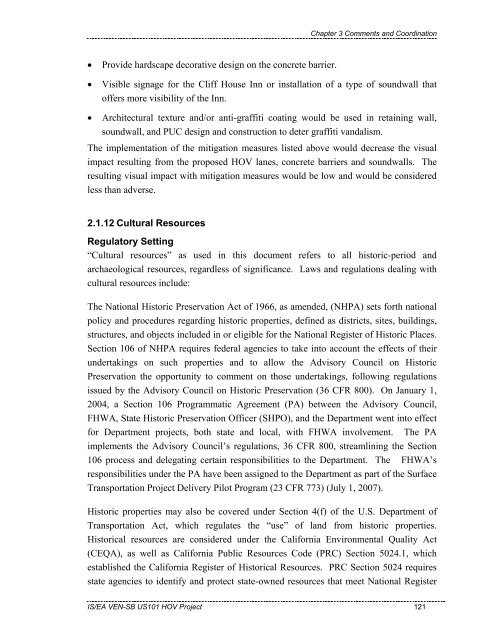Chapter 1 - Caltrans - State of California
Chapter 1 - Caltrans - State of California
Chapter 1 - Caltrans - State of California
You also want an ePaper? Increase the reach of your titles
YUMPU automatically turns print PDFs into web optimized ePapers that Google loves.
• Provide hardscape decorative design on the concrete barrier.<br />
<strong>Chapter</strong> 3 Comments and Coordination<br />
• Visible signage for the Cliff House Inn or installation <strong>of</strong> a type <strong>of</strong> soundwall that<br />
<strong>of</strong>fers more visibility <strong>of</strong> the Inn.<br />
• Architectural texture and/or anti-graffiti coating would be used in retaining wall,<br />
soundwall, and PUC design and construction to deter graffiti vandalism.<br />
The implementation <strong>of</strong> the mitigation measures listed above would decrease the visual<br />
impact resulting from the proposed HOV lanes, concrete barriers and soundwalls. The<br />
resulting visual impact with mitigation measures would be low and would be considered<br />
less than adverse.<br />
2.1.12 Cultural Resources<br />
Regulatory Setting<br />
“Cultural resources” as used in this document refers to all historic-period and<br />
archaeological resources, regardless <strong>of</strong> significance. Laws and regulations dealing with<br />
cultural resources include:<br />
The National Historic Preservation Act <strong>of</strong> 1966, as amended, (NHPA) sets forth national<br />
policy and procedures regarding historic properties, defined as districts, sites, buildings,<br />
structures, and objects included in or eligible for the National Register <strong>of</strong> Historic Places.<br />
Section 106 <strong>of</strong> NHPA requires federal agencies to take into account the effects <strong>of</strong> their<br />
undertakings on such properties and to allow the Advisory Council on Historic<br />
Preservation the opportunity to comment on those undertakings, following regulations<br />
issued by the Advisory Council on Historic Preservation (36 CFR 800). On January 1,<br />
2004, a Section 106 Programmatic Agreement (PA) between the Advisory Council,<br />
FHWA, <strong>State</strong> Historic Preservation Officer (SHPO), and the Department went into effect<br />
for Department projects, both state and local, with FHWA involvement. The PA<br />
implements the Advisory Council’s regulations, 36 CFR 800, streamlining the Section<br />
106 process and delegating certain responsibilities to the Department. The FHWA’s<br />
responsibilities under the PA have been assigned to the Department as part <strong>of</strong> the Surface<br />
Transportation Project Delivery Pilot Program (23 CFR 773) (July 1, 2007).<br />
Historic properties may also be covered under Section 4(f) <strong>of</strong> the U.S. Department <strong>of</strong><br />
Transportation Act, which regulates the “use” <strong>of</strong> land from historic properties.<br />
Historical resources are considered under the <strong>California</strong> Environmental Quality Act<br />
(CEQA), as well as <strong>California</strong> Public Resources Code (PRC) Section 5024.1, which<br />
established the <strong>California</strong> Register <strong>of</strong> Historical Resources. PRC Section 5024 requires<br />
state agencies to identify and protect state-owned resources that meet National Register<br />
IS/EA VEN-SB US101 HOV Project 121

















